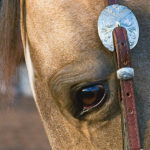
We were camped under aspens at an idyllic spot where two creeks met, our tent on high ground between the gurgling streams, our spirits not dampened by the several inches of new wet snow that weighed down the tent.
We’d rigged a plastic tarp over our cooking area. After knocking the snow off the tarp to restore headroom under it, I fired up the stove and soon had sausage sizzling. Billy untied the three young horses from the highline, hobbling each, and retrieved Little Mack, my “old reliable,” from his picket line and tied him short.
We’re not sure just what happened, whether the cause was a sudden spook or simply the herd instinct to take off for greener pastures, but suddenly, the familiar sound of horses shuffling along in hobbles turned to the distinct rhythms of horses loping, hobbles or no.
Billy, in excellent shape, trotted off to investigate, while I, still relatively unconcerned, sat on my campstool and continued cooking.
Billy returned, exasperated. “I couldn’t catch them! They headed straight up the hill.” By “hill,” he meant the extremely steep, 300-foot vertical bank up which the muddy trail switchbacked. This called for an immediate action drill.
I ran to Little Mack, threw on blanket and saddle, bridled him, unsnapped his lead, and swung on. I remember feeling some pride that I could get my aging body from sedentary camp-cook position to straddling a loping horse in what could not have been more than two minutes.
We splashed through the creek and ascended the bluff following the muddy tracks of the errant colts, worried that they’d run all the way back to the trailhead.
As we crested the hill, though, I breathed more easily. The young horses, Smokey, Redstar, and Jed were standing in a clearing, looking confused and a little foolish. Smokey had slipped his hobbles. The other two had quickly learned that they could climb a steep trail and keep up with Smokey quite easily, hobbles in place.
Lessons learned? The most obvious are: Don’t trust hobbles to hold your horse close to camp; and don’t hobble all your horses — keep an “old reliable” like Little Mack at the ready. But while I was rapidly following those hoofprints on the trail, the oft-quoted old-timer’s saying about holding your horses jumped to mind: “Better to count ribs than tracks!”
By that phrase, the old-timers meant, “Better to have your horse suffer nutritionally because you kept him close than to have to follow his tracks the next day.” The phrase dates from a frontier past when holding onto your horses in the backcountry was essential for survival.
Horse containment in the backcountry will always be an issue for those of us who take our animals far from the beaten track. Today, this issue is further complicated by our ethical concern with “leave no trace” principles and, in some cases, by government regulations.
This in mind, here’s a quick review of five methods for keeping your horse near camp: (1) tying to trees; (2) hobbling;
(3) picketing; (4) using a highline; and (5) using an electric fence.

[PAGEBREAK]
Method #1: Tying to Trees
Only tie your horse to a tree for very brief rest stops or while setting up camp (or taking it down), and only where it’s legal. Horses left tied to trees very long invariably scar the bark with the lead rope. Worse, they’ll paw an unsightly circle around the tree’s base, sometimes exposing the roots.
Hobbling while tied can reduce the damage, but it’s always best to restrict tying to trees to the briefest possible time.
When you must tie to a tree, make sure it’s a solid one. Avoid anything dead or burned, and watch for sharp, protruding branches that could injure your horse. Then, tie high and short, with just 18 to 24 inches of slack at about the natural height of his nose. If he can reach the ground to graze, he’s tied too long. The result can be a foot over the lead rope and a possible wreck.
Method #2: Hobbling
Hobbles nearly immobilize some horses, but most soon learn to lift both front feet in unison and hop toward greener grass.
Hobbles consisting of two padded or leather pieces connected by a chain with swivel are easier on your horse than the single-strap type, but also allow more freedom.
Before you use hobbles in camp, train him at home on a soft surface, such as a sandy arena, in case he falls down. You can limit accidents by training your horse to freely yield to foot restraints. Such training doesn’t take long, and it can pay big dividends down the trail.
To apply hobbles, place them on your horse’s pasterns, just above the hooves, not on the cannon bones over easily damaged tendons. Yes, some tack catalogs show photos of hobbles on the cannon bones, but I’ve never seen an experienced outfitter place them there, and I’m convinced such placement increases the risk of injury.
For safety’s sake, work from your horse’s side, rather than in front of him; if you’re bent down in front of his feet, he could barrel into you. And be especially careful while removing hobbles, since he’ll be anxious to be free and may suddenly jerk his foot away, pinching your fingers.
For increased restraint, three-legged hobbles are available. These have a strap that extends from the center ring between a horse’s front legs, back to one rear pastern. He can still move around to graze, but the characteristic hobble hop (that can quickly turn into a fast hobble lope) is denied him. Three-legged hobbles make sense in treeless areas, where rigging a highline is difficult.
Hobbling is light on the land, since it approximates free-range grazing. However, it’s not an option where grazing is prohibited.
Method #3: Picketing
Picketing further restrains your hobbled horse. Use a rope 25 to 30 feet long and a hobble half. The rope must have a swivel, either on one end or in the middle, and be made from a nonabrasive material, such as soft nylon or a natural fiber. Attach one end to a picket stake (I’ve also used large boulders and heavy logs), and the other to the hobble half. Always picket to one front foot pastern, never to the halter.
Your horse must be trained to hobble before he’s attached to a picket rope. Once he’s comfortable with hobbles, lead him around the round pen with the picket line attached to one front foot, then the other. When you first picket him out, take the slack out of the rope, and tug at his foot to remind him that he’s restrained.

While picketing offers stronger restraint than hobbling, it’s also harder on the terrain. Your horse will soon graze an unsightly circle, so move the picket line frequently. Again, picketing is an option only where grazing is legal.
Method #4: Highline
The highline is the standard tool for tying horses in the backcountry. It consists of a rope suspended between two strong trees, their bark protected by “tree savers” — either commercially made or improvised from pack-saddle cinches.
Build your highline on high, rocky ground, and move it during extended stays, scattering the manure left by your horse and using your shovel to level any ground disturbed by pawing.
The highline rope should be positioned above your horse’s highest head position and should be stretched reasonably tight. Loops in the highline for tying your horse can consist of commercially available “knot eliminators,” or a special but easily tied picket line knot.
I made up a highline by joining a series of short pieces of rope with eye splices, the resulting loops just right for attaching lead ropes.
[PAGEBREAK]
Locate loops about six feet apart or far enough that horses, tied fairly short, can’t become entangled by circling each other. Lead ropes must have a swivel, unless you use the swivel-type knot eliminator.
Train your horse at home by rigging a highline in your corral or arena and tying your horse — along with several other horses — to it for an extended period of time while watching carefully.
Method #5: Electric Fencing
Electric fencing is becoming more common in the backcountry, and for good reason. It allows horses to graze (where legal) with little damage to the environment, because the enclosures can be moved easily.

Kits are available with jointed, lightweight, fiberglass posts, everything needed packed into a small duffle bag. Fence chargers are small and efficient, running several weeks on a set of standard “D” batteries. For horses used to electric fences, all you need is a single strand of highly visible electric tape, properly grounded. Your horse should have his first exposure to electric fencing at home. Horses are extremely sensitive to the nip of electric-fence tape, and, once conditioned, give the tape great respect.
But don’t expect wildlife to respect fencing in the same fashion. Unlike your horse, a moose or deer is unlikely to have been exposed to the bite of an electric fence. Upon first encounter, a wild animal may spook right through the wire, knocking it down and freeing your horse. For this reason, I tie my horses to the highline after the campfire dies.
A more sophisticated electric fencing, called Bear Shock, is also available. (Contact UDAP Industries, Inc.; 800/232-7941; www.udap.com/bearshock.htm.) This fencing, which consists of alternating “hot” and “ground” strands, is commonly used to protect camps, cabins, beehives, and even airplanes from destructive animals, especially bears.
Bears, like horses, can be readily conditioned to respect electric fences, and the many highly visible strands reduce chances an animal will walk through the fence before being repelled by its nip.
On a recent trip, Billy and I got good service from an OK Corral Kit, an electric-fence setup sold by Outfitter’s Supply (888/467-2256; www.outfitterssupply.com). We alternated horses among highlining, hobbling, picketing, and pasturing in the electric-fence paddock. Next time, we’ll also run a tape around our tent and cook area to keep our overly friendly hobbled animals out of the “living room.”
You can extend your electric fence with bungee cords. Natural insulators, the cords can be wrapped around trees without damaging the bark and used in place of additional posts, simultaneously tensioning the fence. In a thickly wooded area, you can set up a good fence using this method entirely, leaving most of your posts (uprights) behind to lighten your load.
Above all, “hold onto your horses!” Every year, horses are lost in the backcountry. And theft, unfortunately, isn’t strictly a thing of the past. Remember the old-timer’s advice, and always keep a steady horse tied close.
And whichever method seems appropriate, pay attention to the health of the backcountry we treasure. Repair any damage your horse causes, and scatter manure in such a way that it fertilizes rather than offends. Happy trails!
For more information on each containment method outlined here, as well as the training involved, see Dan Aadland’s book, The Complete Trail Horse (http://my.montana.net/draa/). Aadland also recommends Francis W. Davis’ book, Horse Packing in Pictures, for its clear
illustrations of the knots involved in picketing,
tying, and highlining.
Dan Aadland raises mountain-bred Tennessee Walking Horses and gaited mules on his ranch in Montana. His most recent books are In Trace of TR; The Best of All Seasons; The Complete Trail Horse; and 101 Trail Riding Tips. For information on Aadland’s horses, books, and clinics, visit http://my.montana.net/draa.





